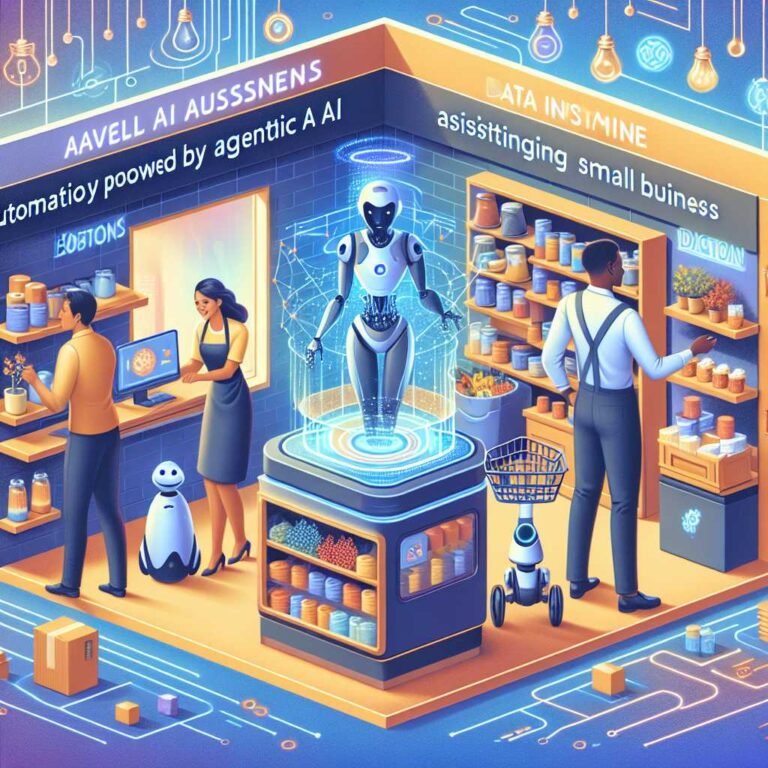It’s Not Magic—It’s AI: How Artificial Intelligence Is Rewriting Marketing (and the World)
If AI still feels like a buzzword or a black box, that’s not your fault. For years, tech talk made it sound like you needed a PhD in machine learning just to have an opinion. You don’t. In fact, the most powerful shift happening in marketing—and across the economy—is not about code. It’s about how we ask better questions, test ideas faster, and turn insights into outcomes. That’s the quiet revolution AI delivers every day.
Here’s the real story: AI is not a crystal ball. It’s a set of tools that turn messy data into decisions, generic messages into personalized moments, and hunches into experiments you can run this afternoon. Whether you’re a solo creator, a startup founder, or a CMO at a global brand, the companies who learn to harness AI right now will set the pace tomorrow. Let me show you how.
AI, Demystified: What It Really Does (and Doesn’t)
Let’s strip out the jargon for a minute. At its core, artificial intelligence analyzes patterns, predicts what comes next, and generates outputs—text, images, audio, even code—based on your inputs. No smoke. No mirrors. Just math.
Here’s why that matters: – AI transforms guesswork into testable hypotheses. You move from “we think” to “we know.” – It compresses time. A day of research becomes 15 minutes of prompts and verification. – It scales creativity. Instead of one idea, you can explore 50—then pick the winner with data.
And here’s what AI doesn’t do despite the hype: – It doesn’t replace strategy. Tools can amplify good strategy or multiply bad decisions. – It doesn’t know your customer better than you—unless you feed it the right context. – It doesn’t eliminate the need for brand judgment, voice, and ethics.
If you treat AI as a decision co-pilot instead of a magic wand, you’ll get the best of both worlds: speed and wisdom.
How AI Is Changing Marketing Today
We’re past the “cool demos” phase. AI is now a practical advantage across the full marketing funnel. Here’s what that looks like in the real world.
1) Research and insights on demand
- AI can synthesize competitor activity, pull out key differentiators, and summarize customer reviews in minutes.
- It can cluster search queries and social comments to reveal unmet needs and language your audience actually uses.
- With the right data, models can forecast demand and identify likely churn before it happens.
Practical example: Ask a model to analyze your past 12 months of customer support tickets, then group them by theme and sentiment. You’ll know what to fix—and what to highlight in your messaging.
2) Content creation that doesn’t sound robotic
- Generative models can produce blog drafts, ad variations, email subject lines, and landing page copy in your brand voice.
- Pair them with style guides and examples to maintain tone consistency.
- Use them for “first drafts” and ideation; keep humans as editors and final decision-makers.
Pro tip: Create a “voice pack” with your best-performing copy and brand rules. Feed that to your model before you ask it to write.
3) Personalization at scale—without creeping people out
- AI can tailor product recommendations, email sequences, and on-site experiences using behavioral signals.
- The goal isn’t to be clever; it’s to be useful. Serve the next best action your customer actually wants.
- Keep it respectful: clear opt-ins, visible controls, and obvious value exchange.
4) Smarter media buying and optimization
- AI-powered platforms automate bidding, budget allocation, and creative rotation across channels.
- You still set the strategy and guardrails; the system handles the heavy lifting.
- Use incrementality testing to avoid paying for conversions you would have won anyway.
5) Measurement that actually helps you decide
- Marketing mix models and uplift studies are getting an AI upgrade, improving confidence in channel impact.
- Instead of fighting over attribution models, use probabilistic approaches to guide spend.
For a deeper dive into end-to-end playbooks, case studies, and ready-to-use prompts, Check it on Amazon.
If you want the receipts: global research shows AI adoption correlates with higher revenue growth, cost savings, and productivity across industries, with marketing among the top beneficiaries. See data from the latest McKinsey State of AI report and practical frameworks in Harvard Business Review.
Which AI Should You Use? A Simple, Practical Guide
There’s no “best” AI tool—only the best one for your job. Here’s how the leading models stack up in plain English.
- ChatGPT (OpenAI): Great all-rounder for brainstorming, drafting, summarizing, coding help, and structured analysis. Strong at following instructions when given examples and constraints. Ideal when you want fast, coherent content and logic.
- Claude (Anthropic): Excellent for long-context tasks (big documents), careful reasoning, and nuanced tone. Often more “cautious” and safe by design. Good for analyzing contracts, research synthesis, and detailed planning.
- Gemini (Google): Integrates well with Google ecosystem and excels in multimodal tasks (text+image+video inputs). Helpful for marketing teams living in Google Ads, Analytics, Docs, and Sheets.
- Grok (xAI): Tuned for real-time, internet-native insights. If you’re working in fast-moving domains (news, trends, social), it can be a strong complement for live monitoring and ideation.
How to choose: 1) Define the job: research, writing, analytics, creative, coding, or data integration. 2) Set non-negotiables: privacy controls, data retention, compliance, long-context needs. 3) Test with your real inputs: your data, your prompts, your formats. 4) Compare outputs for accuracy, tone, and usability. Keep score. 5) Decide whether you need one generalist or a small stack: a writer, a data analyst, and a creative tool.
Comparing tools and not sure what to pick? View on Amazon.
Tip for teams: Don’t lock into a single model too early. Standards shift fast. Many top workflows mix tools: e.g., Claude for long-document analysis, ChatGPT for drafting, Gemini for Sheets automation.
For specifics on safer deployments (PII handling, logging, retention), read guidance from the FTC on AI claims and compliance and explore enterprise controls offered by major providers.
A Practical Glossary (No Fluff)
- Large Language Model (LLM): A model trained on text that predicts the next word; powers tools like ChatGPT and Claude.
- Prompt: The instruction you give an AI model. Good prompts include context, constraints, and examples.
- Fine-tuning: Training a base model on your data to specialize it for your tasks.
- Retrieval-Augmented Generation (RAG): Fetching trusted documents in real time and letting the model read them before answering.
- Embeddings: Numeric representations of text used for semantic search and similarity.
- Guardrails: Rules and filters to prevent undesired outputs (bias, leakage, off-brand voice).
- Hallucination: When a model confidently generates false information. Reduce with RAG, verification, and constraints.
Want the full playbook with templates and case studies? Buy on Amazon.
30 Prompts You Can Use Today (A Curated Starter Set)
You don’t need all 30 right here to start. Here are versatile, high-impact prompts you can adapt to your brand immediately.
Strategy and research: – “Analyze these five competitor landing pages and identify positioning gaps; present a table with headline themes, CTAs, proof, and offers.” – “Cluster these 200 customer reviews by theme and sentiment; extract the top 10 objections and write rebuttal copy for each.” – “Given this ICP, draft a 90-day go-to-market plan with milestones, KPIs, and resource estimates.”
Content and creative: – “Using the attached brand voice guide, write three paid social ad variants for this product, each optimized for a different awareness stage.” – “Turn this blog into a LinkedIn carousel outline with 7 slides, including hooks and CTAs.” – “Draft a video script (60 seconds) for a product explainer; include a storyboard and B-roll ideas.”
SEO and web: – “Generate a topic cluster plan for the keyword ‘AI marketing strategy’ with pillar and cluster pages, search intent, and internal linking.” – “Rewrite this landing page hero and subhead for clarity and conversion; propose two A/B variants.”
Email and lifecycle: – “Create a 6-email onboarding sequence; include subject lines, preview text, and personalization tokens.” – “Write a reactivation campaign for churned users; propose three offer frameworks and a test plan.”
Analytics and optimization: – “Given this dataset, propose three hypotheses for conversion lift; outline an experiment design and sample sizes.” – “Summarize this month’s performance and translate metrics into business insights; include a one-slide exec summary.”
Creative extras: – “Write a brand manifesto in 150 words that captures our values and tone.” – “Create microcopy for three in-app nudges that drive upgrades without being pushy.”
Use these as scaffolding; your context and examples make them powerful.
Real-World Case Studies (Numbers, Not Hype)
- Performance media: A DTC skincare brand used AI to generate and test 120 ad variations across hooks, visuals, and CTAs. After four weeks, click-through rate rose 23% and CPA dropped 18%. The winning angle? A benefit-led headline paired with UGC-style images.
- SEO acceleration: A B2B SaaS company built a topic cluster plan with AI, then had writers refine every draft. Publishing velocity increased 3x, and organic traffic grew 64% in 90 days with improved internal linking and structured data.
- Sales enablement: A mid-market sales team deployed an AI assistant that summarized calls, highlighted objections, and suggested follow-ups. Ramp time for new reps fell from 10 weeks to 6, and conversion from demo to close rose 12%.
- Support deflection: An AI chatbot resolved 42% of Tier 1 tickets end-to-end with human-in-the-loop escalation. CSAT held steady; response times dropped from 8 hours to 10 minutes.
- Predictive retention: A subscription service used churn propensity scoring to trigger tailored offers and content. Churn fell 9% within two months.
If you want to see end-to-end breakdowns, prompts, and templates behind wins like these, See price on Amazon.
For a broader view on AI’s economic impact and productivity gains, explore analyses from OECD AI Observatory and case studies on AI-driven marketing uplift in Google’s resources on AI for marketers.
How to Integrate AI Into Your Company (Even If You’re Starting at Zero)
Think of AI like a new hire with enormous potential. You wouldn’t give them the keys to everything on day one. You’d start small, measure, then scale.
Here’s a practical rollout plan: 1) Pick one high-value use case. Examples: ad creative testing, CRM email optimization, customer support FAQs, sales follow-up summaries. 2) Define your success metrics. Time saved, conversion lift, cost per acquisition, retention change—choose one or two. 3) Create operating guardrails. What data can/can’t be used? Who reviews outputs? Where does human oversight happen? 4) Build your “brand brain.” Collect style guides, voice examples, FAQs, product specs, and past high-performers. Use RAG to keep answers grounded and on-brand. 5) Pilot for 4–6 weeks. Measure impact against a control group. 6) Train your team. A short enablement program beats a giant policy doc. Teach prompting, verification, and escalation paths. 7) Scale what works, sunset what doesn’t. Double down on a few plays that objectively move the needle.
And remember: governance is a feature, not red tape. Clear policies reduce risk and speed up adoption.
Curious what a complete, tested implementation guide looks like in practice? Shop on Amazon.
Risks, Myths, and the Juicy Opportunities
Let’s be candid about the edges.
Common risks: – Hallucinations: Always verify claims and stats. Add citations and use RAG with your trusted sources. – Privacy and IP leakage: Don’t paste sensitive data into unsecured tools. Use enterprise-grade controls or local models where needed. – Bias and fairness: Audit outputs for unintended harm. Diversify training examples and apply fairness checks. – Over-automation: If you automate a broken process, you just make bad outcomes happen faster.
Myths worth debunking: – “AI will replace marketers.” No—marketers who use AI will replace marketers who don’t. The jobs change; the skills evolve. – “One model can do it all.” Stacks win. Use the right tool for the right job. – “Automation kills creativity.” In practice, it frees you to explore more ideas and spend more time on the ones that work.
Opportunities to grab now: – Build a proprietary data moat: Fine-tune or augment models with your performance data and customer insights. – Own a topic: Publish differentiated thought leadership backed by AI-accelerated research. – Design for speed: Shorten your idea-to-test cycle. The faster you learn, the stronger your compounding advantage.
Ready to start applying prompts that actually work today? Buy on Amazon.
The New Frontier: Emotional Marketing, Powered by AI
Emotional resonance has always been the heart of great marketing. AI doesn’t change that—it amplifies it.
How AI helps: – Voice of customer at scale: Analyze thousands of comments and reviews to discover the language of desire and doubt. – Narrative testing: Generate multiple story angles, then A/B test them across channels. – Dynamic creative: Serve different brand stories to different segments without losing cohesion.
But here’s the line you shouldn’t cross: authenticity still wins. Algorithms can propose arcs; humans must decide what’s true to the brand. AI should make your storytelling more empathetic, not more manipulative.
Comparing frameworks or looking for a step-by-step brand storytelling system you can adapt? View on Amazon.
Your First 7 Days with AI in Marketing (A Mini Plan)
Day 1: Document your top three bottlenecks (e.g., content backlog, slow reporting, ad fatigue).
Day 2: Pick one AI use case tied to revenue or time. Set a single success metric.
Day 3: Assemble your brand brain (voice guide, best copy, product FAQs).
Day 4: Draft prompts and run controlled tests (e.g., email subject line variants).
Day 5: Measure results and capture learnings.
Day 6: Share wins, update guardrails, and coach the team on prompt patterns.
Day 7: Decide to scale or switch use cases. Repeat.
Keep it simple. Momentum beats perfection.
Frequently Asked Questions (FAQ)
What is AI in marketing, in simple terms?
AI in marketing uses algorithms to analyze data, predict outcomes, and generate content or recommendations. It helps you research faster, personalize at scale, and optimize campaigns with less guesswork.
Will AI replace marketers and content creators?
No. AI accelerates routine tasks and expands your idea set, but strategy, judgment, and brand voice remain human strengths. Roles will evolve: think “AI-augmented marketers” rather than “replaced.”
Which AI tool is best for copywriting?
ChatGPT and Claude are strong choices; use brand-specific examples to shape tone. Always have a human editor finalize copy and verify facts.
How do I prevent AI from making stuff up?
Provide context and sources (RAG), ask for citations, constrain outputs (tone, length, format), and verify claims. For critical content, require human-in-the-loop review.
Is AI safe for customer data?
It can be—if you set rules. Use enterprise plans with data controls, avoid pasting sensitive PII into open systems, and align with internal security and compliance policies. Review vendor data retention and training practices.
What metrics should I track for AI experiments?
Start with one or two that map to business outcomes: conversion rate lift, cost per acquisition, time saved, or retention improvement. Run A/B or holdout tests where possible.
How can small businesses use AI without big budgets?
Begin with free or low-cost tools for research, drafting, and ad variation testing. Build a simple “brand brain” and aim at one high-impact use case at a time.
Where can I learn more about AI’s broader impact?
Read longitudinal analyses like the McKinsey State of AI and practical marketing applications on Think with Google.
Final Takeaway
AI isn’t magic—it’s leverage. The teams who treat it as a pragmatic partner will outlearn, outcreate, and outpace their competitors. Start with one use case, build your brand brain, measure real outcomes, and evolve your playbook week by week. If this resonated, stick around for more guides, experiments, and prompts you can use right away—and keep turning curiosity into compounding advantage.
Discover more at InnoVirtuoso.com
I would love some feedback on my writing so if you have any, please don’t hesitate to leave a comment around here or in any platforms that is convenient for you.
For more on tech and other topics, explore InnoVirtuoso.com anytime. Subscribe to my newsletter and join our growing community—we’ll create something magical together. I promise, it’ll never be boring!
Stay updated with the latest news—subscribe to our newsletter today!
Thank you all—wishing you an amazing day ahead!
Read more related Articles at InnoVirtuoso
- How to Completely Turn Off Google AI on Your Android Phone
- The Best AI Jokes of the Month: February Edition
- Introducing SpoofDPI: Bypassing Deep Packet Inspection
- Getting Started with shadps4: Your Guide to the PlayStation 4 Emulator
- Sophos Pricing in 2025: A Guide to Intercept X Endpoint Protection
- The Essential Requirements for Augmented Reality: A Comprehensive Guide
- Harvard: A Legacy of Achievements and a Path Towards the Future
- Unlocking the Secrets of Prompt Engineering: 5 Must-Read Books That Will Revolutionize You







